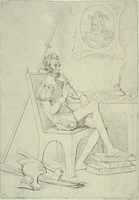Ida Tarbell is a name familiar to Lincoln scholars and Gilded Age historians alike. Our knowledge of Lincoln’s early years is far more rich thanks to her researching (or muckraking, if you will) spirit.
Ferguson says Tarbell was obsessed with Lincoln throughout her life. “After World War I, she went and sort of fulfilled a part of her obsession that she had always wanted to, which was to retrace Lincoln’s movements with his family since he was a little boy, from Kentucky to Indiana and into Illinois. And as she did this, there were still people alive who knew the Lincolns. It’s a part of time that we can’t really get access to any other way,” Ferguson says.
In the days when Lincoln was growing up, Kentucky, Indiana and Illinois were remote areas struggling to develop. “It was just a couple of steps up from the Bronze Age, really,” Ferguson says.
But rather than embracing his hardscrabble background, Foner says, Lincoln distanced himself from frontier culture.
“He doesn’t like hunting, he’s not a violent person, he doesn’t hate Indians, he doesn’t drink. And he understands very early — and where this comes from, who knows — that the way to get ahead is through your mind, not through just hard physical labor, which is what his father does. [Lincoln] gets as far away from the frontier as he can, pretty early,” Foner says.
via Best Books (And Surprising Insights) On Lincoln | WAMU 88.5 – American University Radio.

